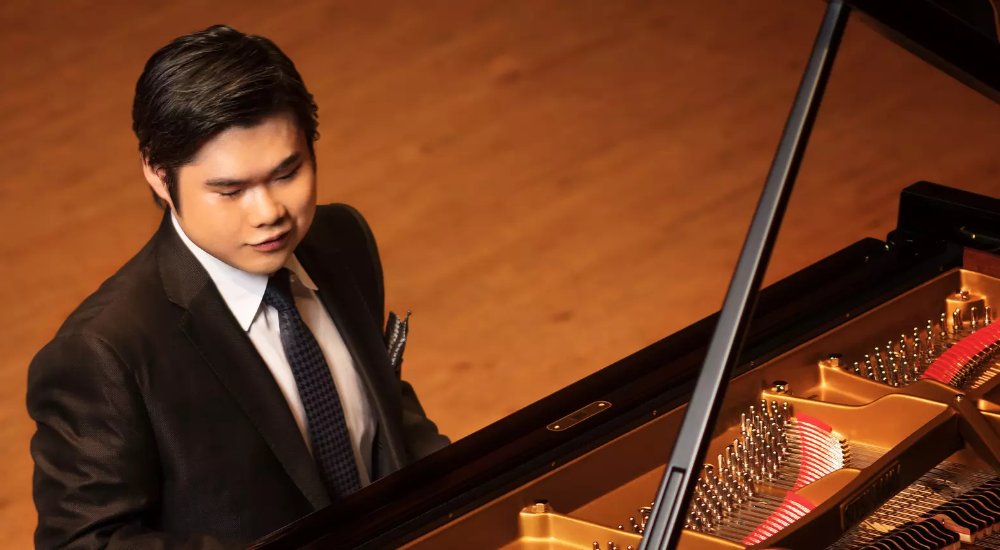Pianist Nobuyuki Tsujii returned to Benaroya Hall on Thursday, this time with a florid and colorful reading of Rachmaninov’s Third Piano Concerto. He thrilled Seattle audiences back in 2013 with Tchaikovsky’s First, and just a few years ago with Rachmaninov’s Second. Fans were vocal in their appreciation of Tsujii, and judging by the empty seats after intermission, many came expressly to hear him.
Among the 30 or so piano concerti considered standard repertoire, the Rachmaninov 3rd in d minor is notorious for its technical difficulty, not to mention the stamina required of the soloist. In some recordings, the piano can sound extraneous, like the cellophane that swaddles a showy bouquet. Thursday’s performance was a more integrated affair.
Uzbek conductor Aziz Shokhakimov gave concise direction from the outset, shaping orchestral tuttis into long, arching phrases. It could be argued this is not so much an interpretive approach as something intrinsic to the score — that the composer built a flexible pulse consistent with breathing into each page. Indeed, Tsujii has confirmed that this is how he gauges attacks without visual cues, by listening for the intake of breath around him.
Tsujii, who is blind from birth, is unique among concert pianists in that he learns by ear.
Colleagues record segments of a work, each hand separately and at intelligible tempi, then Tsujii works to memorize and synthesize the parts into a whole. In this way he assimilates the score as a sighted person might, while avoiding a reliance on pre-existing performances to shape his interpretation.
Toward the end of the first movement, Tsujii chose the ossia (optional) version of the cadenza, a towering edifice of notes, famously black on the page, that Rachmaninov himself did not perform (he played a more shapely, proportional version.) After this precipitous ascent comes the score’s most magical moment, a mile-high elegy for solo flute (Jeffrey Barker) with the mournful main theme suspended by swirling arpeggios on the piano.
For many people, the slow movement melody of the Second Piano Concerto came to define Rachmaninov, which lives on today in Eric Carmen’s “All By Myself.” For me the melancholy tune from the slow movement of the Third is far superior, and Tsujii highlighted its every appearance. After a slight whiff at the outset of the finale, the orchestra and piano took turns at the wheel of the luxuriant main theme. Film composers seem to have used it as a template in the 1930s and ’40s, and these overripe Hollywood knockoffs came to define shmaltz. Shokhakimov and Tsujii managed to avoid that trap by keeping things fleet and unsentimental through the bracing final bars.
Tsujii took six curtain calls, eventually offering Nikolai Kapustin’s finger-twisting Concert Etude op. 40 no. 1 as an encore.
Conducting from memory, Shokhakimov brought less precise direction to Brahms’ Fourth Symphony. This didn’t cause the ensemble to play with any less care. This e minor symphony is built with such rigor and clarity that it survives the haziest of arm-flailing from the podium.
Seated as I was in the middle of the main floor, the orchestral balance tilted toward the violins and cellos. This symphony is a love letter to the string section, so at times the sound bordered on heavy-handed, but for the most part Brahms’ distinctive scoring shone through.
As in the Rachmaninov, Shokhakimov drew big breaths between phrases. In the first movement, I marveled at how Brahms builds such drama from such cellular musical material. In the Andante, principal horn (Jeffrey Fair) set the tone with the doleful main theme, later transfigured into celestial sixths by the violins.
Advocates of this symphony, especially composers like Leonard Bernstein and André Previn, tend to gush about the compositional skill and consummate craft Brahms displays. They marvel at how he examines a musical idea from every conceivable vantage point. I’ve been digesting this music fairly regularly now for about 40 years, and confess I still find some of its episodes a bit prosaic.
Perhaps in polishing every musical facet of these gemlike movements, Brahms leaves some listeners dazzled but cold. There may also be an element of predictability to his compositions: the constant contrapuntal games, syncopation, triplets, sixths, and thirds, not to mention his conservative orchestration.
Familiar as these methods might seem, I find the third movement irresistible. In this almost-a-Scherzo, Brahms lines up a concise set of ideas, pulls them apart and laces them into an exuberant and tightly woven tapestry. Shokhakimov left no daylight between the sunny conclusion of the third movement and the grim Chaconne. Brahms poured unalloyed anguish into this monumental finale, a series of variations on an eight-note theme taken from Bach.
There is a finality to this music, a deep well of gloom. Perhaps that despair came through best in the forlorn flute variation (Demarre McGill), all passing tones of surpassing beauty.
The lid stayed on for this performance, keeping to a steady simmer. This music should convey burning rage and verge on the hysterical. Fine as the playing was, I preferred a bit less bark and a bit more bite.
Discover more from Post Alley
Subscribe to get the latest posts sent to your email.
